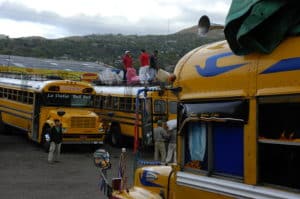
The border crossing at Peñas Blancas is the typical chaos: money changes with huge wads of cordobas, dollars, and colones, a mother and son beggar team, long lines of tired Nicaraguan laborers, and a nun asking for offerings. Before and after the 200-meter Noman’s Land one tractor trailer after another is lined up, most with goods, some overfilled with scrap metal. The authorities of both countries, with aid from the U.S. are trying to make this a transportation bottleneck to keep drugs coming up from South America. A young Nicaraguan going home leads us through the confusing Costa Rican out-line and on to the Nicaraguan in-line and finally out through the last gate into the even more chaotic mercado/bus station area.
Immediately swarmed by eager taxi drivers, my instincts keep me walking through to the only bus waiting. Bound for Rivas in fifteen minutes we sit patiently inside to the blaring Nica music. We are sitting on an American school bus. Still painted yellow, it’s been modified with a roof rack, a high exhaust pipe, and interior luggage racks. This is the way nearly all Nicaraguans get around their country; by sitting on the buses that we rode to school twenty years ago.
San Juan del Sur is a lively beach town with plenty of foreigners and Nicaraguans on holiday, lots of beachside bars, and a beautiful crescent-shaped harbor and beach. The sweet surf breaks keep young Australians, Americans, and Canadians here for weeks at a time. Cheap hotels are seven bucks per night and fantastic beaches line the coast north and south of town.
We’ve come here to study Spanish. We were hoping the surf wouldn´t be too much of a distraction. And it hasn´t been. There are at least four schools that offer week-long classes and full room and board packages. We opted for Rosa Silva´s Spanish School and have had no problem showing up at 8am the past five mornings for our four-hour lesson. My teacher Oscar and I have been reviewing basic Spanish grammar and practicing basic conversation as well. Rosa put us up at her friend Margarita´s place. Either Margarita, her daughter, or her son-in-law cook us three meals a day downstairs in their cafe. Full week-long tuition, room and board is $180.
What do we do with the rest of our day? On Saturday I tried surfing for the first time. The Lopez brothers from Arena Caliente Surf Shop drove about 10 of us in their packed van five miles down to Remanso Beach. With surf board piles high on top we bounced our way on the winding dirt road. Their buddy Shaggy, a real Nicaraguan surfer dude, gave me an hour-long surf lesson. On the beach he taught me jump to my feet and then 15 minutes later I was catching waves and standing on my own.
Besides surfing, there are evening trips to La Flor Beach Wildlife Refuge to see sea turtles laying their eggs in the sand, a zip-line canopy tour just outside town, and plenty of beach bars in San Juan del Sur with ice cold Toña and Victoria beers for $1.25. Most nights we watch the sunset from chairs in the sand at The Pier bar while enjoying a cold one.
And there’s always reviewing the days Spanish notes and doing homework to prepare for the next morning’s lesson.
Stephen Bugno, 03 Dec 2009




Pingback: The Problem with the Backpacker’s Circuit | Bohemian Traveler